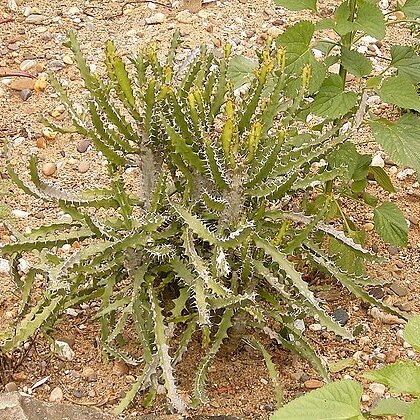A tree, up to 40 ft. high, sometimes with a single trunk up to 6 in. thick, sometimes also with 3-5 trunk-like branches ascending from near the base, slightly 6-8-angled, each with a short broad crown of spreading or ascending-spreading succulent spiny leafless branches and branchlets, usually clustered in whorl-like groups, naked below from the branches being deciduous; main branches at first about 1, ultimately 2 in. or more thick, usually 4-6-angled; flowering branchlets 2/3-1 in. thick, usually 4-5-(sometimes 3-)angled, with concave or nearly flat sides, with or without a few constrictions, rather light green; angles slightly toothed, with the teeth 1/4-3/4 in. apart, armed with spines on young and the lower branches of old trees, but sometimes on old trees the spine-shields are nearly or quite spineless; leaves rudimentary, scale-like; spine-shields 1 1/2-4 lin. long, separate, not forming a continuous horny margin to the angles, lanceolate, cuneate or obovate, bearing a pair of widely diverging spines 1-6 lin. long, without prickles at their base, light brown, finally grey; flowering-eyes touching or partly or wholly included in the spine-shields; cymes solitary, with a peduncle about 1 lin. long, bearing 3 involucres and some small scale-like bracts; involucres 1 1/2-2 lin. in diam., obconic, yellow, with 5 transverse narrowly oblong entire yellow glands; ovary subglobose, exserted on a pedicel not exceeding the involucre, light green; styles free to the base, apparently about 1/3 lin. long, ascending-spreading, subentire at the apex, dull ochreous.
More
Glabrous tree, 3-15 m high, with broad rounded crown of ascending-spreading, often whorled branches, branches not segmented, 15-30 mm thick, (3)4-or 5-angled, slightly concave or flat between angles, pale to dark green, spine shields separate, spines 2-12 mm long. Leaf-rudiments 1-2 x 2-4 mm. Cyathia transversely disposed in 1(-3) cymes per tubercle, on peduncle 1-2 mm long, 5-8 mm in diam.; glands 5, entire, bright green to yellow. Flowering time Oct.-Dec. Capsule 7-9 mm in diam., very obtusely 3-angled, exserted for 2.5-6.0 mm.
Can be grown by seedlings. Seeds needs soaking.


